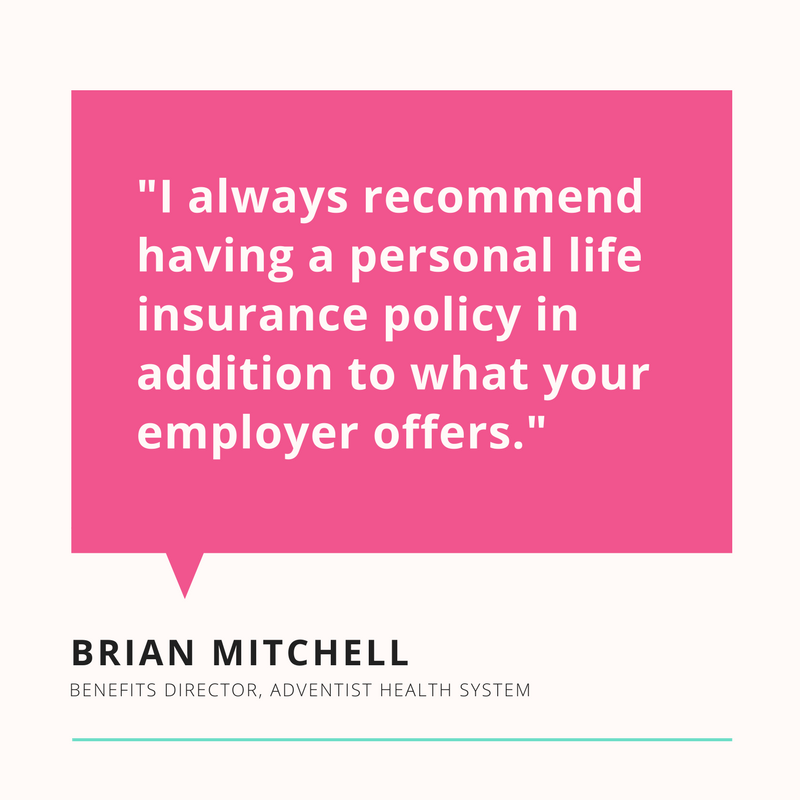I realize that life insurance isn’t the most exciting topic. In fact, some people may not want to think about it at all. If you associate it with coffins and funerals, that makes sense. However, I encourage you to think of it instead as a gift that you leave your family members. It enables them to pay for your final expenses without incurring financial hardship, and it can continue to support them in your absence.

How Does Life Insurance Work?
Remember the piggy bank concept we discussed in this post about medical benefits? Life insurance works in a similar manner. You contribute a fixed amount, called a premium, to the life insurance piggy bank, and it gets combined with premiums from other plan members. When you die, a non-taxable cash payment is pulled from the piggy bank and distributed to the people you’ve selected as your beneficiaries.
There are many different variations of life insurance, but the simplest and most often recommended type is a term policy. This provides coverage for a specific term, or period of time. If you purchase a personal life insurance policy outside of work, the term is a set number of years. In this case, the cost of your premium is individually determined based on the amount of coverage you desire and your risk of dying. If you’re young and healthy, that means you can expect to pay a lower premium. This is one of the reasons it’s good to start contributing to a personal life insurance plan early on in your career.

If you use your employer-provided life insurance policy, then the term is the extent of your employment period. In this kind of policy, the cost of your premium is determined based on the risk associated with the entire population of covered employees.
If you change jobs, get laid off, or become disabled, you may be able to convert your contributions to a personal policy, but usually not at the lower premium rates. There is also a chance that you will lose your employer-provided life insurance benefit completely. For this reason, I always recommend having a personal life insurance policy in addition to what your employer offers.

Most Employers Offer Free Life Insurance Coverage
Most companies provide a basic level of life insurance at little or no cost to employees. This plan usually consists of one times your annual salary or some other fixed dollar amount. In addition, employers offer supplemental life insurance options that allow you to purchase additional coverage. It’s a good idea to take advantage of this low-cost group coverage, especially if you are thinking about replacing your income to support your family.
How Much Life Insurance Do You Need?
How much life insurance you need depends on several factors. If you’re the only person in your household, you probably just need enough to cover your final medical bills and funeral expenses. If you’re married and have children, you also need to plan on replacing the income stream that will help support them. A good starting point is to have life insurance coverage ranging anywhere from 10 to 20 times your annual income.
To get a more accurate estimate, I recommend using the ALEX Benefits Counselor resource mentioned in How to Evaluate Employer Benefits Packages (Part 1), or meeting with a trusted financial adviser who can help you consider related issues and prepare for your family’s future.
Consider Coverage for Spouses & Children
As you’re evaluating employer benefits and making decisions about life insurance plans, you should also consider coverage for stay-at-home spouses and children. Remember that even though your spouse may not bring in outside income, they are still a valuable financial asset to the family because they provide services like cooking, housecleaning, and child care that could cost upwards of $100,000 per year if hired out to a professional. Many policies also provide a lower amount of coverage for children for a very small additional cost.

Remember to Update Your Beneficiaries Regularly
As the busyness of life happens, it’s easy to forget to make updates to your insurance policies, but a quick annual review of your beneficiaries can prevent a lot of problems in the future. For example, imagine the complications when an employee gets remarried and forgets to remove their former spouse from their list of beneficiaries!
Next Week: Disability
We’re almost to the end of our series on benefits packages! Next week we’ll talk about disability and how to prepare for unexpected injuries and illnesses. In the meantime, I encourage you to check out the other benefits posts on Time Off, Health Plans, and Retirement.


